Have invasive roots or a cut tree that requires root removal? You’re not alone. Unwanted or problematic tree roots can pose a risk to foundations, plumbing, and other parts of your property. This fasttreeremovalatlanta.com guide outlines essential methods and safety precautions to effectively remove tree roots, ensuring you can tackle the situation confidently and safely.
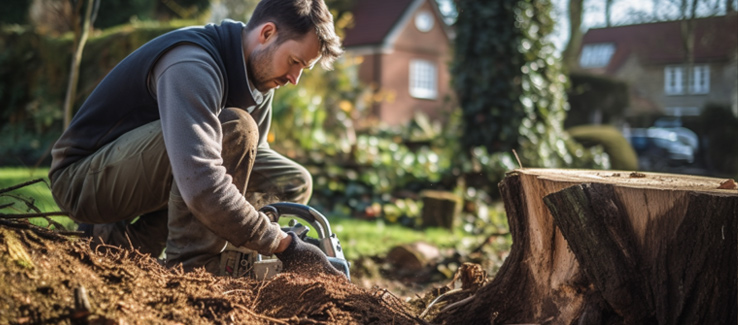
Key Takeaways
- Tree roots continue to grow after the tree is cut down, potentially causing damage to structures, other plants, and property plumbing systems.
- Safe root removal requires equipment, safety gear, and utility line checks. Techniques include manual excavation, stump grinding, chemical treatments, and the rock salt method.
- Post-removal landscape restoration is important and involves digging out roots, cleaning the area, and replanting vegetation to rejuvenate the space.
Understanding Tree Root Systems
The intricate network of tree roots serves two major functions: anchoring the tree in place and absorbing water and nutrients. The system comprises big, robust roots called primary roots and a multitude of smaller roots, often called lateral and feeder roots. These roots work together to keep the tree nourished and stable.
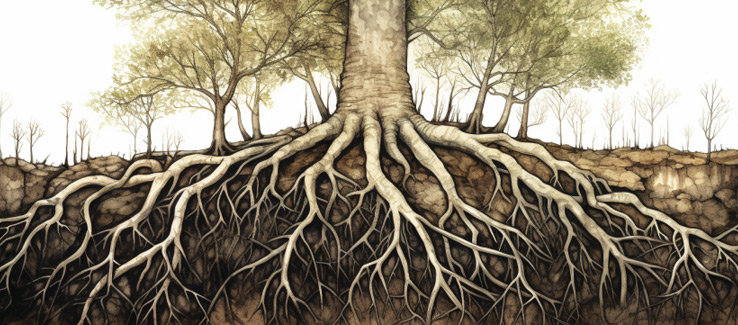
The growth of these roots continues from the cut ends or the base of the trunk even after the tree is removed. They prefer loose, moist soil. After they’re established, the tap root stops growing, and the tree sends out roots sideways. These roots can form lateral root systems, taproot systems, or sinker root systems, which are common types of underground root systems.
Signs That Tree Roots Need Removal
Tree roots become a nuisance once they start causing problems. They can:
- Push up against buildings, resulting in structural damage
- Suck up water and nutrients, leaving little for other plants in the vicinity
- Expose roots that can release chemicals that inhibit the growth of nearby plants.
How does one determine if tree roots are causing harm to nearby plants? Look for signs such as:
- Sparse foliage
- Wilting leaves
- Overall declining plant health
- Root girdling, where roots encircle the trunk or other roots, restricting water and nutrient uptake
- Dry soil conditions affecting the health of other plants
These signs can point towards an issue with surface tree roots.
In addition to affecting other plants, tree roots can cause problems with plumbing. They can infiltrate pipes, causing leaks or blockages, leading to soggy yards and dangerous sinkholes. In such cases, tree stump removal may be necessary.
Safety Precautions Before Removing Tree Roots
Before embarking on a tree root removal mission, it is imperative to take all necessary safety precautions. One of the critical steps is contacting utility companies. You want to avoid damaging any underground utilities and causing property damage or injuries. Also, remember that only trained utility personnel should handle tasks near powerlines.
Equipping oneself with the appropriate gear is a vital step. Ensure you have gloves, safety glasses, ear protection, and chainsaw pants or chaps. It’s also recommended to wear sturdy boots and appropriate clothing. Having the right tools, such as chainsaws, hand saws, pruning shears, ropes, ladders, and shovels, not only makes the job easier but also safer. These tools are designed for tree and stump removal, and using them properly reduces the risk of accidents or injuries and ensures the surrounding soil is not damaged.
Top Techniques for Tree Root Removal
Several techniques exist to eliminate pesky tree roots. These include:
- Manual excavation
- Stump grinding
- Chemical treatments
- The rock salt technique
Each method has its own set of pros and cons and is suited to different scenarios.
Here’s a closer examination of each technique.
Manual Excavation
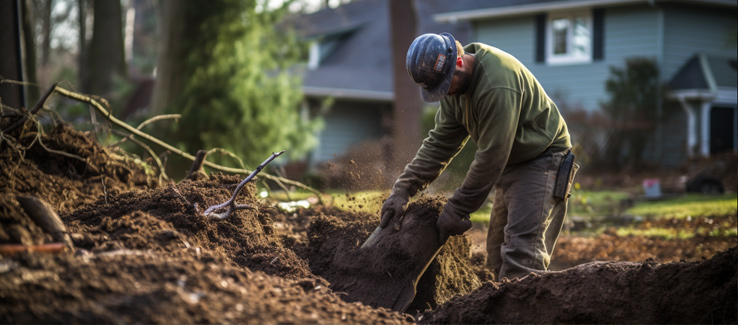
Manual excavation requires a hands-on approach, utilizing garden tools to uncover and expose tree roots. The tools you’d need for this mission include:
- Post hole diggers
- Augers
- Spades
- Shovels
- Hoes
- Trowels
- Rakes
- Pick axes
- Mattocks
To ensure your safety during this process, use garden loppers, or a hand root pruning saw to cut the roots. If the roots are large, an electric reciprocating saw would be your best bet. Always remember to wear gloves and eyewear for protection.
The process begins with cutting down the tree. Then, dig around the stump to expose the roots. Finally, use a chainsaw or a similar tool to cut through the roots for stump removal.
Tip: Maintaining a safe distance from other tree trunks during digging helps to prevent damage to their root system. For instance, if a tree has a 2-foot diameter, avoid digging within a 10-foot radius of its trunk.
Stump Grinding Method
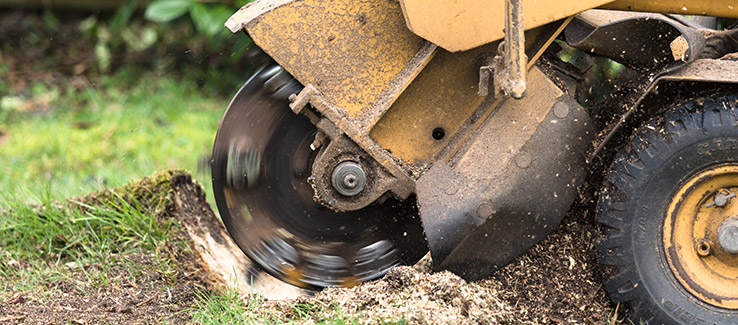
Another efficient method for eliminating tree stumps and large surface roots is stump grinding. This process involves:
- Using a machine to grind down the tree stump from top to roots
- Shaving off layer by layer until the whole stump and big roots are ground down
- Effectively stopping them from growing back.
Safety is paramount during stump grinding. Here are some important safety tips to keep in mind:
- Clear the area of any debris
- Stay at the controls while the grinder is in operation
- Ensure the stump doesn’t move around
- Lift heavy objects properly to avoid back injuries
- Always wear appropriate safety gear
- Before initiating the stump grinder, finding and marking all utility lines is imperative.
Using a skid-steer stump grinder can help you remove the stump precisely and lower the chance of hitting underground structures.
Chemical Treatment Approach
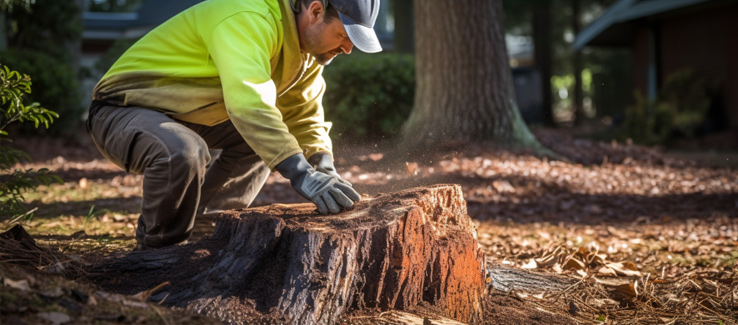
Another alternative for tree root removal is the use of chemical treatments. Glyphosate-based herbicides are commonly used for this purpose. You simply drill some holes around the stump and apply the herbicide with a small paintbrush. However, safety is paramount when using chemicals for tree root removal because it’s critical that the chemical does not contact your skin.
Choosing appropriate chemicals, applying them right after cutting the tree, and covering the stump to hinder chemical spread is vital. Always follow the instructions on the label when mixing and applying herbicides.
Note: Chemical treatments tend to be slower than other methods. It can take a few weeks for large, old root systems to die off completely after the application of chemical treatments.
Rock Salt Technique
Although slower, the rock salt technique proves effective for tree root removal. It involves:
- Drilling holes into the tree stump and exposed roots
- Filling the holes with rock salt
- Covering the stump with soil
- Watering the stump every 2-3 days to dissolve the salt
The salt dries out the stump and kills the roots over a period of months. However, it’s crucial to remember that using rock salt can impact the surrounding plants and soil. The salt can burn leaves, kill plants, and damage roots, rendering the soil unusable for a long period. Be mindful when employing this method, because while it is cost-effective, there can be unintended effects.
Addressing Tree Roots Under Concrete & Through Plumbing Pipes
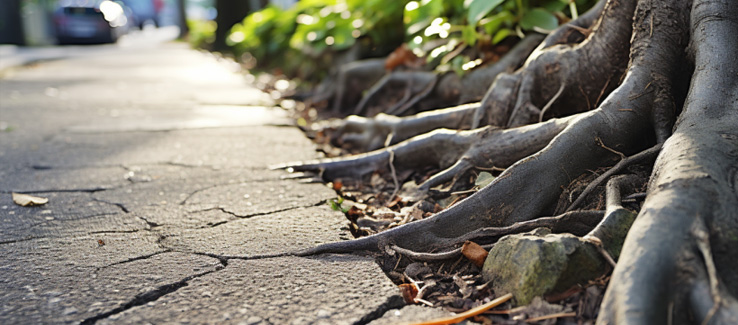
Dealing with tree roots under concrete or in plumbing pipes poses unique challenges. However, solutions do exist. For instance, chemical treatments like copper sulfate and rock salt can be used to safely get rid of tree roots by cutting off their water and nutrient supply.
Using tools like a root or a reciprocating saw for tree roots under concrete can allow you to carefully cut the roots without damaging the concrete. Installing a root barrier can also prevent further growth.
For roots interfering with plumbing, using substances like potassium hydroxide or copper sulfate can stunt their growth, or a copper sulfate septic treatment can poison the soil around the pipes and keep the roots away.
Protecting Nearby Trees While Removing Roots
Preserving the health ofsurrounding trees during root removal is of utmost importance. One way to ensure this is by working with an arborist. An arborist will employ methods like install root barriers to protect from equipment and excavation damages and use fresh wood mulch to prevent soil compaction.
Caution is critical during tree root removal to avoid damaging other trees significant roots. Removing roots safely is important to minimize damage to other roots, as it can hinder these tree’s ability to absorb water and nutrients, increase its susceptibility to windthrow, and disturb a tree’s critical root zone.
Weighing the Pros and Cons of DIY vs. Professional Tree Root Removal
The choice between self-removal and professional assistance is a decisive factor in the tree root removal process. DIY removal can cost anywhere from $175 to $500 for equipment and the proper tools, while hiring a professional can cost from $94 to $163 per hour, plus an additional $150 to $500 for complex jobs.
DIY tree root removal requires specific tools such as:
- a compact digger
- gardening shears
- chainsaw
- hatchet
- handsaw
- stump grinding machine
It’s a viable option for simple tasks, provided you have the right tools and know-how. However, hiring a professional for complicated jobs is safer and ensures better results.
Opting for a DIY approach carries potential risks like injuries, tool mishandling, and possible property damage.
Tips for Restoring Your Landscape After Tree Root Removal
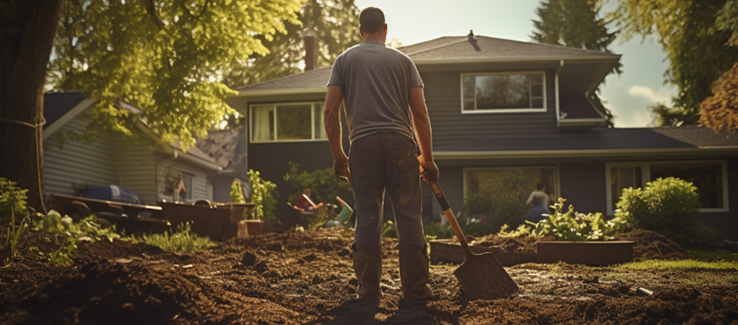
Once the ordeal with the tree roots ends, landscape restoration begins. Here are the steps to follow:
- Start by digging out any remaining roots so you can level the ground.
- Wash away any remaining dirt or debris with a garden hose or power washer.
- If you have the stump grindings, you can cover the area with mulch.
You can also enrich the soil by mixing ground-up chips and compost to fill the empty space. Incorporating topsoil and organic materials like compost can help rejuvenate the area. Planting new vegetation, such as spruce trees, can bring back greenery to the spot.
After the restoration, keep an eye on the tree’s health by checking the canopy density, perimeter shape, and color. These indicators should return to normal once the rehabilitation efforts start working.
Tree Root Removal Summary
Tree root removal can be an involved task, but with the proper knowledge, tools, and techniques, it’s absolutely achievable. Whether you opt for manual excavation, stump grinding, chemical treatments, or the rock salt technique, safety should always be your top priority. And remember, preserving the tree’s health and the surrounding landscape is just as important as removing the troublesome roots.
Root Removal Frequently Asked Questions
These are the more common tree root removal questions:
What is the best way to remove tree roots?
The best way to remove tree roots is to cut them using garden loppers or a hand-root pruning saw. You can also use an electric reciprocating saw, or a mini electric chain saw, but take care to avoid cutting too close to the base of the tree for larger trees.
Is it OK to remove exposed tree roots?
No, removing exposed tree roots is not okay because it can cause them to decay and harm the tree. Instead, protect and cover the roots with topsoil or mulch to prevent damage.
Do tree roots keep growing after tree removal?
Yes, tree roots may continue to grow after a tree is removed, but they will eventually die due to a lack of photosynthesis from leaves.
Can you remove tree roots without damaging the tree?
Yes, removing tree roots without damaging the tree by pruning only the visible roots is possible. If you must cut roots, make sure to prune those with a diameter less than a few inches thick and leave the thicker roots for stability and health.
How to remove tree stumps?
To remove a tree stump, you can dig around the stump, cut the larger roots, then lift and remove the stump from the ground. Finally, fill the hole with dirt and cover it with topsoil or mulch.
(404) 220-9963
To view the orignal version of this post, visit: https://www.fasttreeremovalatlanta.com/tree-root-removal-guide

Thanks for sharing this amazing informative post with us i found this helpful for many services in the field of demolition, with a specialization in residential and commercial demolition. Demolition Services In Sacramento
ReplyDeleteNice blog! thank you for sharing this information. GBA Service
ReplyDelete